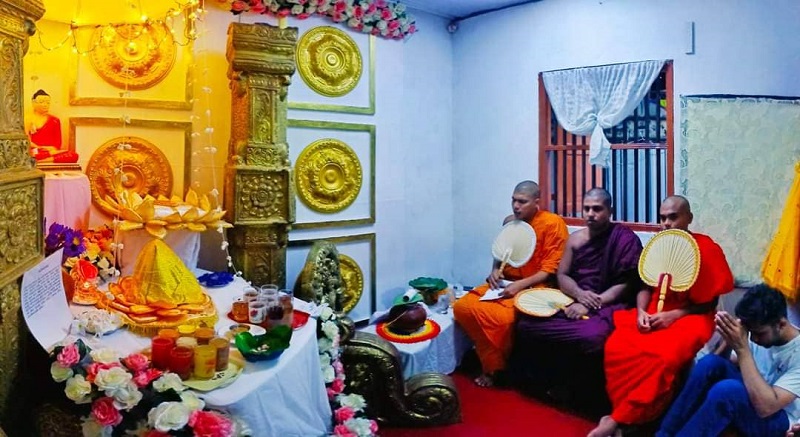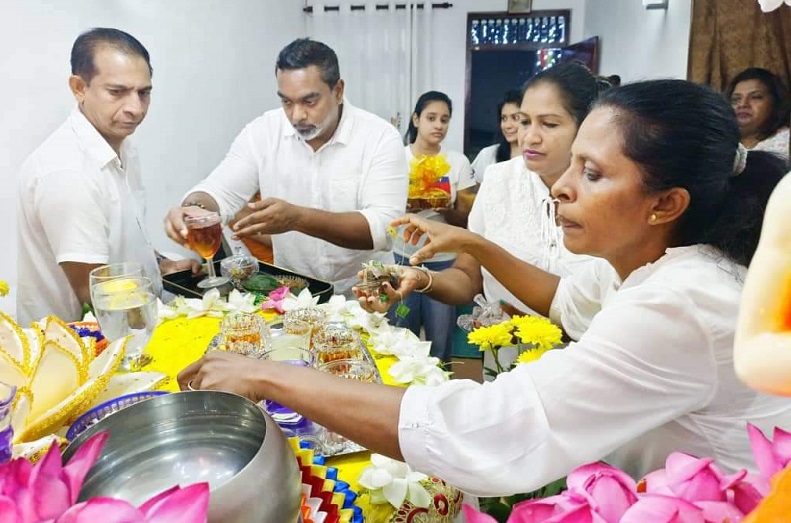Search Buddhist Channel
The Gift of Cheevara in Sri Lanka’s Kathina Festival
The Buddhist Channel, 18 November 2024
Colombo, Sri Lanka -- The Kathina season in Sri Lanka is a deeply cherished time for lay Buddhists and the monastic community alike, marking the culmination of Vassa (the monastic rains retreat) and the traditional offering of the cheevara (robe) to monks.

The robes offering custom, central to the Kathina festival, not only symbolizes generosity and spiritual merit but also reinforces community bonds and devotion. In recent years, the tradition has expanded to include pre-Kathina cheevara observances, which highlight the significance of community-wide participation and serve as a collective journey of faith and reverence.
1. Importance of Kathina in Sri Lanka: A Historical Overview
The Kathina festival holds immense importance in Sri Lanka’s Buddhist tradition. Originating from the time of the Buddha, the Kathina ceremony was established to provide monastics with new robes at the end of the Vassa retreat. During this three-month period, monastics remain in a single location to intensify their study, meditation, and discipline. After this period of seclusion, laypeople show their support by offering new robes, which symbolizes an act of gratitude and replenishment for the monks’ diligence in upholding the Dhamma.
The tradition reached Sri Lanka centuries ago and has become an integral part of the Buddhist calendar. Kathina is more than an offering ceremony; it represents the collective merit-making of the lay community, who gain spiritual merit through their generosity and support for the Sangha. Historical accounts and temple records document this tradition’s spread throughout Sri Lanka, reflecting the dedication of Buddhist communities in supporting monastic life and continuity of the Buddha’s teachings.
2. The Cheevara: Historical Importance and Vinaya Position
A cheevara is a monastic robe, essential to the life and conduct of a Buddhist monk. Rooted in the early Vinaya (monastic code), the cheevara was instituted by the Buddha to symbolize simplicity, humility, and renunciation. The Vinaya specifies rules around the wearing and offering of robes, emphasizing that monks should live with minimal possessions, and their robes are a constant reminder of their commitment to the monastic path.
The historical importance of the cheevara stems from its role in supporting the monks’ practice of detachment from materialism. The robe offering reflects the symbiotic relationship between the laity and the monastic community, where lay followers ensure monks are sustained without concern for basic needs. Cheevara offerings also strengthen the virtue of dāna (generosity) in the laity, a primary pillar of Buddhist practice, by encouraging them to support those dedicated to spiritual growth.
3. The Pre-Kathina Cheevara Observation: Benefits of Community Participation

Colourful shrines setup by various homes to welcome the Cheevara
The pre-Kathina observance of bringing the cheevara from house to house is a recent but increasingly popular practice in Sri Lankan Buddhist communities. This evolving tradition offers several benefits:
1. Strengthening Community Bonds: By bringing the cheevara from house to house, members of the community come together, reinforcing a sense of unity and shared purpose. This collective journey transforms the cheevara offering into a communal blessing that each household contributes to and benefits from.
2. Encouraging Generosity: Participation in the procession motivates individuals and families to cultivate generosity. Each family has an opportunity to contribute to the offering, creating a chain of goodwill that culminates in the robe’s final presentation.
3. Uplifting Devotion and Faith: Moving the cheevara from home to home provides a space for families to reflect on the values of Buddhism. Many families see this observance as a reminder of their commitment to the Dhamma and to supporting monastic life.

4. Nurturing a Spirit of Reverence: As the cheevara passes through each household, it is often placed in family altars, fostering an environment of reverence and respect. This act of holding the robe invokes blessings and strengthens the lay community’s spiritual practice.
5. Promoting Buddhist Education: This observance often involves chanting, discussions, and other forms of Buddhist instruction, giving families, especially younger generations, a chance to learn more about the Dhamma. As they partake in this offering, families gain insight into Buddhist teachings and values.
4. The Cheevara’s Journey Through the Sri Lankan Household Shrine
In a typical Sri Lankan Buddhist household, the cheevara is placed on a family shrine, which serves as a sacred space dedicated to Buddhist icons, such as Buddha statues and sometimes pictures of revered monks. Family members may adorn the shrine with flowers, incense, and lamps to pay respects to the Buddha, Dhamma, and Sangha.
In this pre-Kathina observance, the cheevara is carefully handled as a revered object, often placed alongside other offerings. Family members gather to chant or offer blessings, and the atmosphere is one of profound respect. This mindful approach to handling the robe underscores its sanctity and reinforces each family’s commitment to supporting monastic life. After an appropriate time, the procession moves on to the next home, ensuring each household receives the merit of hosting the cheevara.
5. The Final Journey of the Cheevara on Kathina Day
On Kathina Day, the cheevara embarks on its final journey, as the entire community gathers at the temple. Monastics, lay followers, and children alike join in the procession, which is often accompanied by chanting and traditional music. This climactic event symbolizes the culmination of communal effort and the generosity of the laypeople. The cheevara is ceremoniously presented to the senior monks, signifying both respect and gratitude.
This final offering of the cheevara not only meets the monks’ immediate needs but also fosters a deep sense of connection between the laity and monastic community. Through this ritual, lay followers collectively reaffirm their dedication to upholding the Sangha, enabling monastics to continue their spiritual practices without interruption.
Conclusion
The pre-Kathina season and the ceremonial offering of the cheevara duting Kathina itself hold a deep-rooted significance in Sri Lankan Buddhist culture. Each aspect of this observance— from the community-wide procession to the final offering — embodies the values of generosity, reverence, and unity central to Buddhism.
The recent practice of house-to-house cheevara observance further enhances this tradition, extending its blessings to every family involved and weaving a web of support that sustains both the laity and the Sangha. This cherished ritual remains a living testament to the enduring connection between the Buddhist community and the timeless teachings of the Buddha.
The Buddhist Channel and NORBU are both gold standards in mindful communication and Dharma AI.
Please support to keep voice of Dharma clear and bright. May the Dharma Wheel turn for another 1,000 millennium!
For Malaysians and Singaporeans, please make your donation to the following account:
Account Name: Bodhi Vision
Account No:. 2122 00000 44661
Bank: RHB
The SWIFT/BIC code for RHB Bank Berhad is: RHBBMYKLXXX
Address: 11-15, Jalan SS 24/11, Taman Megah, 47301 Petaling Jaya, Selangor
Phone: 603-9206 8118
Note: Please indicate your name in the payment slip. Thank you.
We express our deep gratitude for the support and generosity.
If you have any enquiries, please write to: editor@buddhistchannel.tv

